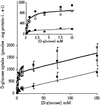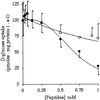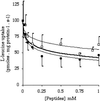Direct inhibitory effect of rotavirus NSP4(114-135) peptide on the Na(+)-D-glucose symporter of rabbit intestinal brush border membrane
- PMID: 11000215
- PMCID: PMC112375
- DOI: 10.1128/jvi.74.20.9464-9470.2000
Direct inhibitory effect of rotavirus NSP4(114-135) peptide on the Na(+)-D-glucose symporter of rabbit intestinal brush border membrane
Abstract
The direct effect of a rotavirus nonstructural glycoprotein, NSP4, and certain related peptides on the sodium-coupled transport of D-glucose and of L-leucine was studied by using intestinal brush border membrane vesicles isolated from young rabbits. Kinetic analyses revealed that the NSP4(114-135) peptide, which causes diarrhea in young rodents, is a specific, fully noncompetitive inhibitor of the Na(+)-D-glucose symporter (SGLT1). This interaction involves three peptide-binding sites per carrier unit. In contrast, the Norwalk virus NV(464-483) and mNSP4(131K) peptides, neither of which causes diarrhea, both behave inertly. The NSP4(114-135) and NV(464-483) peptides inhibited Na(+)-L-leucine symport about equally and partially via a different transport mechanism, in that Na(+) behaves as a nonobligatory activator. The selective and strong inhibition caused by the NSP4(114-135) peptide on SGLT1 in vitro suggests that during rotavirus infection in vivo, NSP4 can be one effector directly causing SGLT1 inhibition. This effect, implying a concomitant inhibition of water reabsorption, is postulated to play a mechanistic role in the pathogenesis of rotavirus diarrhea.
Figures




Similar articles
-
Rotavirus infection impairs intestinal brush-border membrane Na(+)-solute cotransport activities in young rabbits.Am J Physiol Gastrointest Liver Physiol. 2000 Sep;279(3):G587-96. doi: 10.1152/ajpgi.2000.279.3.G587. Am J Physiol Gastrointest Liver Physiol. 2000. PMID: 10960359
-
Rotavirus NSP4 114-135 peptide has no direct, specific effect on chloride transport in rabbit brush-border membrane.Virol J. 2006 Nov 13;3:94. doi: 10.1186/1743-422X-3-94. Virol J. 2006. PMID: 17101044 Free PMC article.
-
Age-dependent diarrhea induced by a rotaviral nonstructural glycoprotein.Science. 1996 Apr 5;272(5258):101-4. doi: 10.1126/science.272.5258.101. Science. 1996. PMID: 8600515
-
How do the rotavirus NSP4 and bacterial enterotoxins lead differently to diarrhea?Virol J. 2007 Mar 21;4:31. doi: 10.1186/1743-422X-4-31. Virol J. 2007. PMID: 17376232 Free PMC article. Review.
-
I. Glucose galactose malabsorption.Am J Physiol. 1998 Nov;275(5):G879-82. doi: 10.1152/ajpgi.1998.275.5.G879. Am J Physiol. 1998. PMID: 9815014 Review.
Cited by
-
Antidiarrheal Action of Bacillus subtilis CU1 CNCM I-2745 and Lactobacillus plantarum CNCM I-4547 in Mice.Front Microbiol. 2018 Jul 10;9:1537. doi: 10.3389/fmicb.2018.01537. eCollection 2018. Front Microbiol. 2018. PMID: 30042756 Free PMC article.
-
Rotavirus enterotoxin NSP4 binds to the extracellular matrix proteins laminin-beta3 and fibronectin.J Virol. 2004 Sep;78(18):10045-53. doi: 10.1128/JVI.78.18.10045-10053.2004. J Virol. 2004. PMID: 15331737 Free PMC article.
-
The Role of Ion Transporters in the Pathophysiology of Infectious Diarrhea.Cell Mol Gastroenterol Hepatol. 2018 Mar 5;6(1):33-45. doi: 10.1016/j.jcmgh.2018.02.009. eCollection 2018. Cell Mol Gastroenterol Hepatol. 2018. PMID: 29928670 Free PMC article. Review.
-
Role of macrophages in the altered epithelial function during a type 2 immune response induced by enteric nematode infection.PLoS One. 2014 Jan 23;9(1):e84763. doi: 10.1371/journal.pone.0084763. eCollection 2014. PLoS One. 2014. PMID: 24465430 Free PMC article.
-
Rotavirus toxin NSP4 induces diarrhea by activation of TMEM16A and inhibition of Na+ absorption.Pflugers Arch. 2011 May;461(5):579-89. doi: 10.1007/s00424-011-0947-0. Epub 2011 Mar 12. Pflugers Arch. 2011. PMID: 21399895
References
-
- Alvarado F, Brot-Laroche E, Delhomme B, Serrano M A, Supplisson S. Heterogeneity of sodium-activated d-glucose transport systems in the intestinal brush-border membrane: physiological implications. Boll Soc Ital Biol Sper. 1986;62:110–132.
-
- Alvarado F, Halaihel N, Ball J M, Estes M K, Vasseur M. Rotavirus nonstructural glycoprotein NSP4 abolishes SGLT1 activity of brush border membrane vesicles from rabbit jejunum. Z Gastroenterol. 1998;36:326.
-
- Alvarado F, Vasseur M. Theoretical and experimental discrimination between Cl−-H+ symporters and Cl−/OH− antiporters. Am J Physiol. 1996;271:C1612–C1628. - PubMed
-
- Alvarado F, Vasseur M. Direct inhibitory effect of CCCP on the Cl−-H+ symporter of the guinea pig ileal brush-border membrane. Am J Physiol. 1998;274:C481–C491. - PubMed
-
- Ball J M, Tian P, Zeng C Q-Y, Morris A P, Estes M K. Age-dependent diarrhea induced by a rotaviral nonstructural glycoprotein. Science. 1996;272:101–104. - PubMed
Publication types
MeSH terms
Substances
Grants and funding
LinkOut - more resources
Full Text Sources
Other Literature Sources

